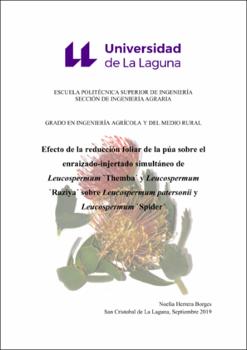Efecto de la reducción foliar de la púa sobre el enraizado-injertado simultáneo de Leucospermum "Themba" y Leucospermum "Raziya" sobre Leucospermum patersonii y Leucospermum "Spider"
Author
Herrera Borges, NoeliaDate
2019Abstract
The proteas market began in the Canary Islands in the eighties and now covers 60
ha between Tenerife, La Palma and Gran Canaria. The production in the islands is
specially focused on the gender Leucospermum, being the most important: Lp.
`Succession I´, Lp. `Succession II´, Lp. `Tango´, Lp. `Soleil´, Lp. `High Gold´, Lp.
`Sunrise´ and Lp. `Vedfire´. To study the propagation of Leucospermum through the
simultaneus rooting and grafting, a test was carried out in wich the rootstock Lp. `Spider´
and Lp. pattersonii were compared, these being tolerant to clayey or alkaline-clayey soils,
and the comercial cultivars Lp. `Themba´ y Lp. `Raziya´ were used as scions.
Additionally, the leaf reduction was studied and the wounding was carried on the
rootstock base and the bagging of the graft to favour its maintenance. Both rootstocks
were used unrooted to evaluate the concurrent rooted-grafted using the slit graft. The
rooting of the stakes was carried out in a well-ventilated umbraclum with 50% reduction
in natural light, using a substratum composed by peat-polystyrene 4:6 v/v, with bottom
heat (22 ± 2°C) and under a fogging system. A random blocks desing was used with 8
treatments and 3 repetitions, performing 15 grafts per treatment. At the end of the test,
Lp. patersonii obtained the best results. Furthermore, it was observed that the rootstock
Lp. patersonii with the scion Lp. `Themba´ and whole leaves showed the highest
percentage (31%) of transplantable stakes with live scion. With regard to the rooting
index, there were no significant differences during the study. El mercado de las proteas se inicia en Canarias en los años 80, desde entonces
hasta ahora cuenta ya con unas 60 ha repartidas en las islas de Tenerife, La Palma y Gran
Canaria. La producción en las islas se centra sobre todo en el género Leucospermum,
siendo los más importantes: Lp. `Succession I´, Lp. `Succession II´, Lp. `Tango´, Lp.
`Soleil´, Lp. `High Gold´, Lp. `Sunrise´ y Lp. `Vedfire´. Para estudiar la propagación de
Leucospermum mediante el enraizado e injertado simultáneo, se llevó a cabo un estudio
en el que se compararon los patrones Lp. `Spider´ y Lp. pattersonii, tolerantes a suelos
arcillosos, y como púas se emplearon los cultivares comerciales Lp. `Themba´ y Lp.
`Raziya´. Además, se estudió el efecto de la reducción foliar y se llevó a cabo el lesionado
en la base del patrón y el embolsado de la púa para favorecer su mantenimiento. Ambos
patrones se utilizaron previamente sin enraizar para evaluar el enraizado-injertado
simultáneo, utilizándose el injerto de hendidura. El enraizamiento de las estacas se llevó
a cabo en un umbráculo ventilado y con una reducción de la luz natural del 50%,
empleando un sustrato compuesto por turba y poliestireno 4:6 v/v, con calor de fondo (22
± 2°C) y bajo un sistema de nebulización. Se empleó un diseño de bloques al azar, con 8
tratamientos y 3 repeticiones, realizándose 15 injertos por tratamiento. Al final del
ensayo, Lp. patersonii obtuvo los mejores resultados, además se observa que el patrón
Lp. patersonii con la púa Lp. `Themba´ y hojas enteras mostró el mayor porcentaje de
estacas trasplantables con púa viva, un 31%. Con respecto al índice de enraizamiento, no
hubo diferencias significativas a lo largo del ensayo.





